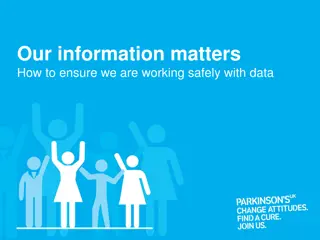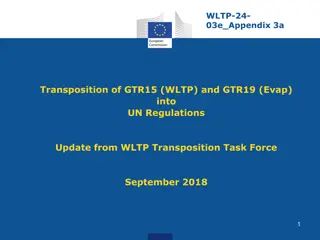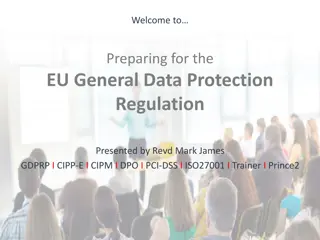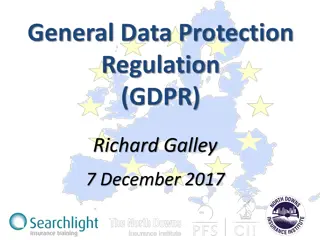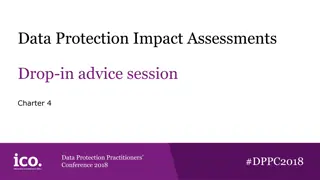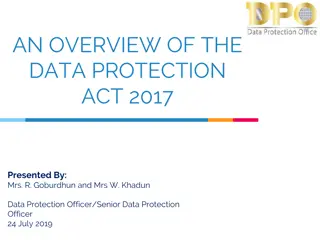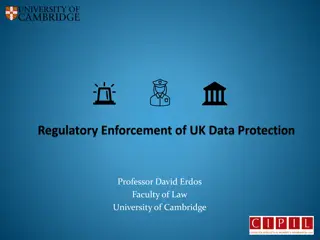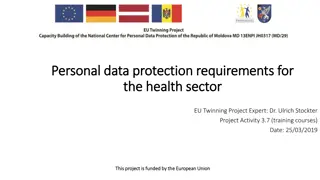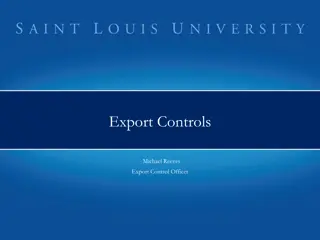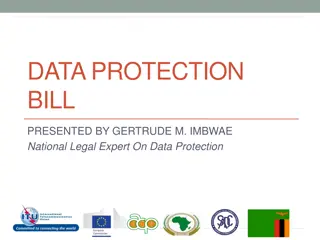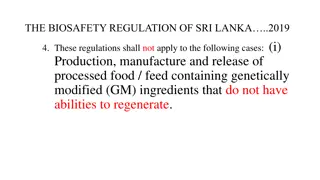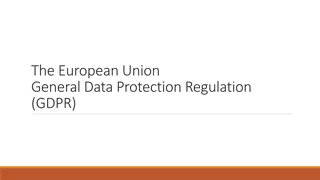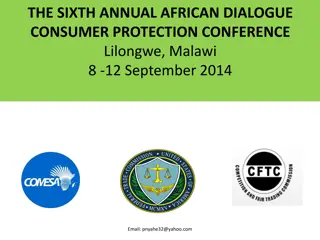Understanding Data Protection Regulations and Definitions
Learn about the roles of Data Protection Officers (DPOs), the Data Protection Act (DPA) of 2004, key elements of the act, definitions of personal data, examples of personal data categories, and sensitive personal data classifications. Explore how the DPO enforces privacy rights and safeguards personal data under the Ministry of Technology. Gain insights into the powers of the Commissioner, obligations on data controllers, the Data Protection Register, rights of data subjects, exemptions, and other key aspects of data protection regulations.
Uploaded on Oct 04, 2024 | 0 Views
Download Presentation

Please find below an Image/Link to download the presentation.
The content on the website is provided AS IS for your information and personal use only. It may not be sold, licensed, or shared on other websites without obtaining consent from the author. Download presentation by click this link. If you encounter any issues during the download, it is possible that the publisher has removed the file from their server.
E N D
Presentation Transcript
Managing Data Protection By 1. Mrs Protection Officer/Senior Data Protection Officer) 2. Mrs Rushda Goburdhun(Data Protection Officer/ Senior Data Protection Officer) Pravina Dodah (Data 1 5th April 2017
DATA PROTECTION OFFICE (DPO) The DPO, under the aegis of the Ministry of Technology, Communication and Innovation enforces Protection Act. the Data Mission of DPO Safeguard the privacy rights of all individuals with processing of their personal data. regard to the 2
DATA PROTECTION ACT (DPA) 2004 AN ACT To provide for the protection of the privacy rights of individuals in view of the developments techniques used transmit, manipulate, store data relating to individuals. in capture, record the to or 3
THE MAIN ELEMENTS OF THE ACT The Data Protection Act contains 8 parts namely: I. II. III. Powers of Commissioner IV. Obligation on Data Controllers V. The Data Protection Register VI. Rights of Data Subjects VII. Exemptions VIII. Miscellaneous Preliminary Definitions etc Data Protection Office 4
DEFINITIONS Personal Data means a) data which relate to an individual who can be identified from those data; b) data or other information, including an opinion forming database, whether or not recorded in a material form, about an individual whose identity is apparent or can reasonably be ascertained from the data, information or opinion; part of a 5
EXAMPLES OF PERSONAL DATA Employee Name Non Employee Clients Address, Details, ID Card Name, Contact Surname Suppliers Address, Email, Phone Residential Address Telephone Number Contractors Email, Contact Person Phone, ID Card Bank Account Number 6
DEFINITIONS (cont.) Sensitive Personal Data: Membership to Trade Union Religious / Similar Belief Physical / Mental Health Political Opinion / Adherence Sexual Preferences / Practices Sensitive Personal Data Racial / Ethnic Origin Criminal Convictions 7
DEFINITIONS (cont.) Processing means any operation or set of operations which is performed on the data wholly or partly by automatic means, or otherwise than by automatic means, and includes collecting, organising or altering the data; retrieving, consulting, using, storing or adapting the data; disclosing the disseminating or otherwise making it available; or aligning, combining, destroying the data; data by transmitting, blocking, erasing or 8
DEFINITIONS (cont.) Data Controller means a person who, either alone or jointly with any other person, makes a decision with regard to the purposes for which and in the manner in which any personal data are, or are to be, processed. e.g. Mammouth Trading CO Ltd is a data controller since it processes employee and non employee data. 9
FUNCTIONS OF THE DPO REGISTRATION OF DATA CONTROLLERS IN MAURITIUS I INVESTIGATION OF COMPLAINTS II III CONDUCT PERIODICAL COMPLIANCE AUDITS SENSITISATION IV V EXERCISE CONTROL ON ALL DATA PROTECTION ISSUES RESEARCH ON DATA PROCESSING AND COMPUTER TECHNOLOGY VI 10
8 DATA PROTECTION PRINCIPLES Principle 1: Fairness Personal data must be collected and used fairly and lawfully. Principle 2: Transparency Personal data must be obtained only for any specified and lawful purpose, and shall not be further processed in any manner incompatible with that purpose. Principle 3: Quantity Personal data must be adequate, relevant, and not excessive in relation to the purpose for which they are processed. Principle 4: Accuracy Personal data must be accurate and, where necessary, up to date. 11
8 DATA PROTECTION PRINCIPLES Principle 5: Time limit Personal data must not be kept for longer than necessary. Principle 6: Individuals rights Personal data shall be processed in accordance with the rights of data subjects. Principle 7: Security Appropriate security measures must be implemented to prevent personal data being accidentally or deliberately compromised. Principle 8: International transfers Personal data shall not be transferred to another country unless that country ensures an adequate level of protection for the rights of data subjects in relation to processing of personal data. 12
HOW CAN AN ORGANISATION MANAGE DATA PROTECTION? Identify a data protection lead It is good practice to identify a person or department responsible for developing, implementing and monitoring the policy. data protection 13
HOW CAN AN ORGANISATION MANAGE DATA PROTECTION? Awareness of security measures Section 27(2) of DPA An reasonable steps to ensure that any person employed by him is aware of and complies with security measures. organisation must take all the relevant 14
HOW CAN AN ORGANISATION MANAGE DATA PROTECTION? Registration/Renewal as Data Controller Section 33(2) & Section (34) - A data controller must register with the Data Protection personal data being processed. Office for all Section 38 - Registration should be renewed annually. 15
HOW CAN AN ORGANISATION MANAGE DATA PROTECTION? Data Quality and Accuracy An review information to identify when to correct inaccurate records and remove irrelevant ones. organisation should regularly 16
HOW CAN AN ORGANISATION MANAGE DATA PROTECTION? Privacy notices To ensure that the processing of data is fair, it is a good practice to include privacy notices on an organisation s website and any other forms that is used to collect data. These reasons for using the data, including any disclosures. notices should clearly explain the Example: All details provided on this form will remain strictly confidential and will be kept and processed only for [purpose/s] as specified by the company and in accordance with Data Protection Act 2004. Your information may be shared with [list of parties] for the following purposes [list of purposes]. 17
HOW CAN AN ORGANISATION MANAGE DATA PROTECTION? Privacy notices It is good to mention here that in case an organisation wants to use personal data in a manner different to its privacy notice, then prior consent to use or disclose personal data is required from the data subject unless the exceptions listed under section 24(2) of the DPA applies where an organisation can proceed without prior consent. 18
HOW CAN AN ORGANISATION MANAGE DATA PROTECTION? Exceptions from Consent Section 24(2) of DPA (2) . personal data may be processed without obtaining the express consent of the data subject where the processing is necessary - (a) for the performance of a contract to which the data subject is a party; (b) in order to take steps required by the data subject prior to entering into a contract; (c) in order to protect the vital interests of the data subject; (d) for compliance with any legal obligation to which the data controller is subject; (da) for the purpose of making use of a unique identification number to facilitate sharing information and avoid multiple registrations among public sector agencies; (e) for the administration of justice; or (f) in the public interest. 19
HOW CAN AN ORGANISATION MANAGE DATA PROTECTION? Retention and Disposal The fifth principle of the DPA requires that personal data should not be kept for longer than necessary. It is important to note that the DPA does not set any time limit to retain data. The onus lies on the data controller to determine the time retention based on the purpose for which data is being kept and in accordance with other laws such as Employment Rights Act, Income Tax Act, Banking Act, National Archives Act etc.. 20
HOW CAN AN ORGANISATION MANAGE DATA PROTECTION? Access Request Rights The sixth principle of the DPA requires that personal data is processed in accordance with individual rights. Under section 41 of the DPA, a data subject has the right of access to information that the organisation holds about him/her. An individual can make a written request to see and obtain a copy of his/her information being held upon payment of the prescribed fee to the organisation. You should therefore have a process in place to recognise and respond to requests within statutory timescales. 21
HOW CAN AN ORGANISATION MANAGE DATA PROTECTION? Exemptions from Data Access Request There are exemptions within the DPA (S43) which may controller to refuse to comply with a data subject s access certain circumstances. For example: - if there is not enough evidence to identify the individual. - if it is an offence under any other enactment to provide the personal information. - if the information is confidential and concerns the data subject s health, education and work. - if it concerns data for another individual allow a data request in 22
HOW CAN AN ORGANISATION MANAGE DATA PROTECTION? Security Policy The seventh principle of the DPA requires that personal data appropriate security measures. is protected by Before you can decide what level of security is right for your business, you will need to assess the risks to the personal data you hold and choose the security measures that are appropriate to your needs. 23
HOW CAN AN ORGANISATION MANAGE DATA PROTECTION? Transfer of Data Abroad As per section 31(1) of the DPA, no data controller shall, except with the written authorisation of the transfer personal data to another country. Commissioner, Organisation must fill and submit to the Data Protection Office the Transfer of Personal Data Form http://dataprotection.govmu.org. available on 24
HOW CAN AN ORGANISATION MANAGE DATA PROTECTION? Privacy Impact Assessments Build in privacy considerations at the start of projects or initiatives that involve the processing of personal data. Thinking about privacy early on will reduce risks and avoid costly changes at a later date. DPO web application to assess your organisation's compliance status with the Data Protection Act 2004: http://dataprotection.govmu.org/English/Publications/ Pages/Privacy-Compliance-Assessment.aspx Guideline: http://dataprotection.govmu.org/English/Documents/ Publications/Guidelines/DPO_Vol6_PrivacyImpactAs sessment.pdf 25
HOW CAN AN ORGANISATION MANAGE DATA PROTECTION? Disclosure of Information An organisation must ensure that personal information in its disclosed in any manner incompatible with the purposes for which such data has been collected, which is an offence under section 29 of the Data Protection Act. possession is not The principle is that the prior consent from the concerned data subject should be obtained before any disclosure is made, unless you fall under the exceptions of section 24(2) of the DPA. 26
HOW CAN AN ORGANISATION MANAGE DATA PROTECTION? Data Sharing Data sharing refers to sharing of data within an organisation or sharing of data from one or more organisation to other organisation(s) If you are sharing client data, the DPA will apply. Consent of client is required before any data sharing takes place unless you fall under the exceptions of 24(2) or 25(2) of the DPA. 27
HOW CAN AN ORGANISATION MANAGE DATA PROTECTION? CCTV at Work Data collected by the CCTV cameras is under the responsibility of the data controller and therefore the data controller is required to comply with the Data Protection Act for the collection of personal data. CCTV Images should be captured only within the premises of the company. A sign at all entrances should be displayed to specify: the purpose/s for which the surveillance is being carried out, the identity of the organisation, the contact details of the organisation 28
HOW CAN AN ORGANISATION MANAGE DATA PROTECTION? CCTV at Work (cntd.) A Guide titled Vol 5 Guidelines to regulate The Processing of Personal Data by Video Surveillance Systems is available on the Data Protection (http://dataprotection.govmu.org/English/Do cuments/Publications/Guidelines/Guidvol5v 3.pdf) under publications. Office website 29
HOW CAN AN ORGANISATION MANAGE DATA PROTECTION? Fingerprint for attendance purposes Requires consent of workers. However, under sections 24 and 25 of the DPA, consent is not required where the data controller is able to show that it falls under the exemptions of section 24(2) or 25(2). In organisation Fingerprint system. In case no consent is received, alternative (less intrusive)methods for recording attendance must be provided. case consent can is obtained, using the the continue 30
OFFENCES AND PENALTIES Subject to Section 61 of the DPA, any person who contravenes this ACT shall commit an offence. Where no specific penalty is provided for an offence, the conviction, be liable exceeding 200,000 imprisonment for a term not exceeding 5 years. person to rupees shall, fine and on not to a 31
Resources The Data Protection Act 2004 http://dataprotection.govmu.org/English/L egislation/Pages/Data-Protection-Act- 2004.aspx The Data Protection website http://dataprotection.govmu.org/English/P ages/default.asp Guidelines http://dataprotection.govmu.org/English/P ages/Guidelines/Publications--- Guidelines.aspx 32
THANK YOU! 33





